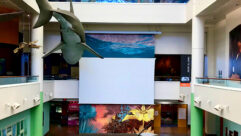Chicago Field Museum of Natural History’s James Simpson Theater, Part 2
Mar 25, 2014 10:46 AM,
With Bennett Liles
Listen to the Podcasts

Editor’s note: For your convenience, this transcription of the podcast includes timestamps. If you are listening to the podcast and reading its accompanying transcription, you can use the timestamps to jump to any part of the audio podcast by simply dragging the slider on the podcast to the time indicated in the transcription.
The grand and beautiful James Simpson Theater at Chicago’s Field Museum of Natural History got a new 3D cinema system, and they needed a new sound setup to go with it. Clearwing Productions was called in on the project and Megan Henninger is going to tell us how they got the job done. That’s up next on the SVC Podcast.
SVC: Megan, welcome back for part two on the SVC Podcast and we were talking about the James Simpson Theater in the Chicago Field Museum of Natural History. Fantastic theater, very old building and you were not allowed to do much that might alter the beautiful look of the place, but you got a new L-Acoustics sound system in there to go with their new 3D projection. When they called in Clearwing Productions what was the first thing on your to do list when you got into the place?
We crawled around in all the spaces to see what our options were for hanging speakers—speaker placement—because obviously, looking at it the first thing they said is, “We don’t want to see anything; we just want to hear them.” So definitely that was the biggest challenge, trying to assess out where we can actually put things that would work, that was feasible, that we were going to be able to hear things well. So it was definitely a challenge as far as compromising on placement versus the aesthetics of the room and trying to figure that all out. [Timestamp: 1:48]
And with such a grand old pristine white interior, you probably had a few somewhat nervous people from the facility looking over your shoulder to see what your people were doing.
We definitely did. The management from the museum was extremely concerned about it, and they checked in with us often during the course of submitting the proposal and of course, putting everything in. [Timestamp: 2:09]
What was the timeline on this whole project? You actually had to get some elements of the old sound system out first, right?
We did. Going in, from the time the contract was signed until opening was less than a month, so it was a pretty tight timeline. We really wanted to open the 3D cinema at the beginning of summer, so Memorial Day weekend in May, and we signed the contract the first of May. It was a pretty quick timeline. And as things go with older buildings, you run into the unexpected and have hang-ups along the way. We tried to get going as early as possible, anticipating that we would find some of those and we got it in on time, and it was up and running. [Timestamp: 2:51]
And did you run into any architectural surprises in that old place when you were running the wiring for all of those speakers? You used a lot of them.
We did, and luckily the museum staff, electricians, and carpenters helped us out with that because they’re so familiar with the space and because it’s so old and kind of delicate. They did a lot of the wire running and a lot of the infrastructure rigging for us, especially for the surround. We were very thankful for their help with that because it would have taken us twice as long to figure out what was going on up there than someone who was familiar with the space already. [Timestamp: 3:24]
A whole different approach with an old building where you have to be so careful and then other projects where you get in during the construction phase and you can run all your stuff and just sort of let the sawdust fly. Now, when they’re using the theater, how and from where do they control the new sound system? They’re using the LA-4 amplified controller?
Yeah, the LA-4; there’s a rack backstage, and luckily there’s kind of a control room off the stage so we didn’t have to put it onstage. We were able to save them room for their events on stage that way. So that’s all kind of backstage right. Everything runs from there, and that was pretty easy. The electricians helped piping power in for us and conduit for the speaker wires, so partnering with them on that was a fairly easy part of the job. [Timestamp: 4:12]
And I think L-Acoustics has a network control software application for that.
The L-A Manager, yeah. We certainly used that for setup and tuning of the room.
Chicago Field Museum of Natural History’s James Simpson Theater, Part 2
Mar 25, 2014 10:46 AM,
With Bennett Liles
I was looking at some of the screenshots from that. It looks like they have a virtual 4-channel mixer. I guess the hardware is two ins and four outs.
It is, and there’s processing, of course, in there and delay and whatnot and some EQ. So we didn’t do much to it. I mean the speakers sound great. We just delayed everything so it was in time because I think I didn’t mention this before, but the left, center, and right clusters weren’t all in a straight line in a plane because of how we had to hang the screens. The center speakers are actually upstage of the screen. The screen is perforated. It’s meant to have speakers shooting through it. And the left and right are little bit more downstage but to the sides of the screen because I think you can see those big white columns on the photo in the middle of the stage. There are two of them and they divide the stage in thirds. So because those were right where you would want to put your left and right speakers upstage, we couldn’t put them there and if we moved them over to the sides of the columns, then we were kind of shooting into the proscenium wall. So it was important for us to get the speakers downstage of that a little so we’d have a clear shot at the audience. Luckily they hide very neatly in the drapes on the sides of the screen and we’re able to cover better from those positions. But that did mean we had a little more to do with tuning and balancing the system because we had to delay those to the center cluster, and we had to EQ the center cluster a little differently being that it was behind the movie projection screen, and the left and right were not. By the time we were done and we turned it over to the 3D cinema folks for tuning, everything sounded flat, had a flat response, and they were pretty pleased with the results. [Timestamp: 6:11]
What all do they do in there? I know they have the 3D cinema now, but do they ever have any sort of live sound or performances?
They tell me that they do on occasion. It’s not one of the main things they do, but they will have live music presentations. When we went into the space, there was already an analog snake infrastructure that was run between the front-of-house position and the stage. So for the install, they upgraded the sound console from analog mixer and we provided a Midas Pro One digital mixer. But it’s still run over the analog infrastructure to the stage, but it gives them a lot more processing power out there, a lot more plug-ins that they can use in a smaller package, and they can still do bands very easily with the analog infrastructure between front of house and the stage area. [Timestamp: 6:58]
What area are you covering with the 5XT fill speakers?
The 5XT fills; it covers basically the first two rows in the audience level right by the front of the stage.
And those are concealed right along the front edge of the stage?
Yes, they are. Yep.
I know they’re small but how did you go about hiding those?
There were mounting points underneath the stage where the previous speakers were and they ended up working out placement-wise for the 5XTs. We just angled them to the desired angle. They were pretty much sunk in the concrete that makes up the stage deck. So the electricians ran our speaker cable down there and we were able to access those pretty easily by crawling under a hatch under the stage. I could actually stand up down there. I’m pretty short, so it worked out. [Timestamp: 7:45]
You have so many different speakers in different locations in there. You probably have a lot of customized control so if they want to do something besides just the cinema they should have plenty of options.
There are. We have a couple of presets preprogrammed for them. One is, of course, the 3D cinema preset and the other is a preset for your corporate or music acts which takes the center cluster out of the picture being that it’s so far upstage and would be shooting into microphones of a band or a presenter. So that’s all controllable out front with the touch screen interface. And other than that it’s just pretty much you have control of the system from the sound console, but it should be a plug-and-play kind of thing. It should be ready to go. [Timestamp: 8:28]
How long after you got it all hooked up did it take to ring it all out and test it?
We were in there for about a day ringing it out before we handed it over to the cinema. It wasn’t really as difficult as we anticipated. It was actually pretty easy to ring out.
Well, that’s always nice when it actually comes out easier than you thought it was going to be.
We weren’t sure with the acoustics of the room how that would work out, but luckily we were able to get those speakers in places where the pattern was pretty controlled so we didn’t have a whole lot of bounce, no slapback to worry about. We got the placement pretty good at the first go so that made tuning a breeze. [Timestamp: 9:05]
Okay, and you’ve got this one done so what’s coming up next for Clearwing Productions? What have you sort of got in the pipeline?
The next major thing we’re working on right now is a church. We’re getting ready to get going on that. We’re doing the sound, light and video. It’s a new construction so not so much crawling around in the ceilings of old buildings or anything, so we’re pretty excited about that. [Timestamp: 9:28]
That’s going to take a whole different mindset when you can get in there during the construction phase and do whatever you want.
Definitely. It’s a different beast, but you know you have challenges with everything so we’re looking forward to it.
Alright. Megan Henninger from Clearwing Productions and the James Simpson Theater at Chicago’s Field Museum of Natural History. The whole museum is fantastic. I’d love to visit up there sometime when everything is thawed out.
Don’t go to Chicago in the winter.
Alright Megan, that’s a great project and thanks for telling us the story.
Well, thanks for having me. I appreciate the opportunity.










